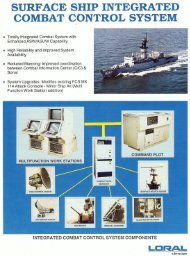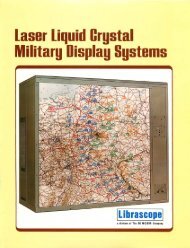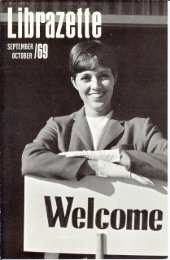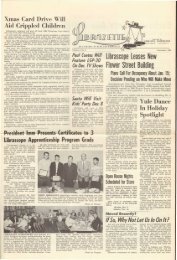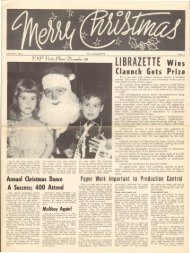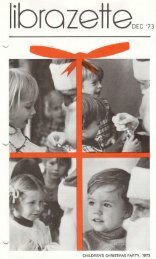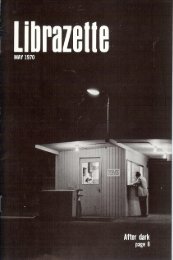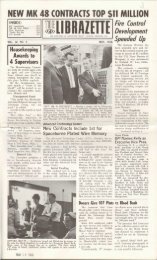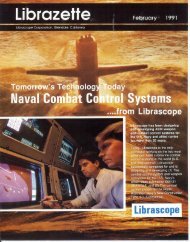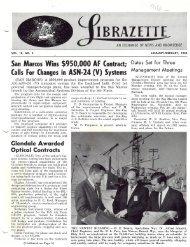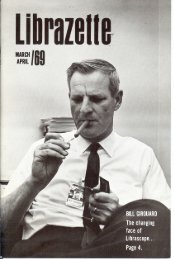Technical Review - Fall 1959. - Librascope Memories
Technical Review - Fall 1959. - Librascope Memories
Technical Review - Fall 1959. - Librascope Memories
Create successful ePaper yourself
Turn your PDF publications into a flip-book with our unique Google optimized e-Paper software.
BIO<br />
\.\.\ \ F .//././<br />
\\\**///<br />
BIO<br />
///I<br />
// / M ZZZT<br />
B20 /<br />
B40 B100 B4D<br />
0 /<br />
B100<br />
Block diagram of system<br />
from the drum. Following the trial run<br />
the punched tape is fed through a tape<br />
reader and put into printed form by an<br />
electric typewriter.<br />
The twelve variables, monitored every<br />
three seconds, are scanned and recorded<br />
on the magnetic drum in approximately<br />
0.8 millisecond. This interval, considered<br />
in relation to the speed at which<br />
the variables undergo change, is essentially<br />
simultaneous.<br />
The analog variables are converted<br />
to a binary-coded decimal form for<br />
recording. This is accomplished with<br />
commutator-type, shaft-to-digital encoders.<br />
The values of 17 functions are<br />
transmitted by synchros, two are stepmotor<br />
functions and time is generated<br />
with a synchronous motor.<br />
Servos position both the analog-todigital<br />
encoders and display dials. A<br />
camera photographs the dials at the<br />
same instant that the converters are<br />
scanned electrically. The camera provides<br />
an alternate record in case of<br />
malfunction in the digital scan and<br />
memory unit during a test.<br />
To obtain the 17 synchro variables,<br />
the stator terminals of synchro generators<br />
in the fire control system are<br />
connected in parallel with the stator<br />
Memory drum turns at 3450 rj>m<br />
terminals of synchro control transformers<br />
in the recorder. The input signal<br />
to each servo amplifier is then taken<br />
from the rotor winding of the appropriate<br />
control transformer.<br />
The amplifiers may be used in either<br />
60-cycle or 400-cycle servo loops. Each<br />
amplifier has a crossover network for<br />
two-speed use. Each module of four<br />
amplifiers has its own separate, regulated<br />
power supply.<br />
Four amplifier modules are used for<br />
16 of the synchro signals. A special<br />
amplifier is used for the 17th, which is<br />
transmitted at 1100 cycles. This signal<br />
is demodulated and is converted to halfwave<br />
60-cycle pulses, phased with the<br />
1100-cycle signal.<br />
A disc-type shaft-to-digital encoder<br />
is used. The commutator-type disc consists<br />
of concentric rings which correspond<br />
to the weighted values of the<br />
brush locations. A binary-coded decimal<br />
(1-2-4-8) code is used. A two-brush<br />
pickoff system eliminates ambiguity.<br />
Each disc is divided into 200 divisions<br />
to produce coded numbers from 000<br />
to 199. Encoders with larger output<br />
ranges are used for the time conversion<br />
in the system.<br />
The encoder outputs are sampled by<br />
Commutator segment<br />
a high-speed scanning technique to provide<br />
parallel binary-coded decimal data.<br />
The scan and memory circuits are all<br />
packaged in the form of printed plug-in<br />
circuits. (Each circuit "card" is color<br />
coded for rapid identification.)<br />
Input sampling and selection of signals<br />
from each of the 20 encoders must<br />
be maintained in a predetermined sampling<br />
sequence. A program counter<br />
designates 44-word intervals through a<br />
circuit of six flip-flops.<br />
The scan and program counters operate<br />
continuously during a run. They are<br />
synchronized with the memory drum.<br />
Whenever a data sample is made, a<br />
record-recirculate flip-flop provides the<br />
time period required to locate the right<br />
data storage point in the memory.<br />
The magnetic memory drum has 1584<br />
engraved time points on the clock track.<br />
This is exactly six times the number of<br />
bits in the 44-word recirculation storage.<br />
Record and read heads on the<br />
four binary-coded decimal recirculation<br />
tracks are placed approximately 264<br />
time points (44 words) apart. This provides<br />
an operating frequency of about<br />
100 kilocycles. The access time to the<br />
number storage is about three milliseconds<br />
when the drum is driven by a




